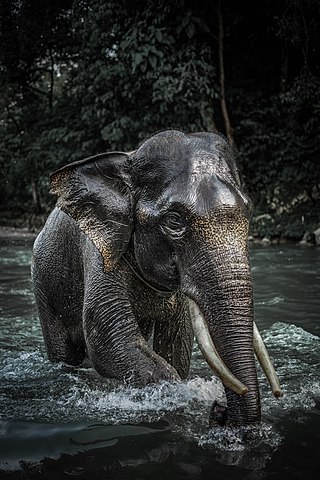Vuljeac Elephant
The Vuljean Elephant was once numerous throughout the hilly forests in southern Tamaris. They are still a common beast of burden in the Vuljea and Argyl regions. Though historical records depict other species of elephant, the Vuljean Elephant is the only one left. In Gora Nos, the elephant is prized as a status symbol, and most tamed elephants are used for ceremonial purposes where they are lavishly decorated.
Basic Information
Anatomy
Vuljeac Elephants are large four-legged mammals that are mostly hairless. Their nose is elongated into a trunk which they use for grasping food and drinking. They have large sensitive ears which are used for cooling themselves off. Their feet are flat with three toenails and a tough foot pad.
Ecology and Habitats
Elephants live mostly in forests where they eat leaves and branches. They prefer warm and humid environments. Due to their lack of hair, elephants are incapable of living anywhere where it regularly stays below freezing for an extended period of time. They can travel large distances in search of food and most elephant herds rotate between foraging areas.
Additional Information
Social Structure
Elephants are matriarchal in the wild with a dominant female leading a herd of other females and their calves. Male elephants are solitary, though small bachelor herds of juvenile males are not unheard of. In captivity, most elephants defer to a handler as the leader, though it is an unnatural social structure.
Uses, Products & Exploitation
They were originally used for labor particularly pulling logs and transporting people. Their tusks are used for piano keys and statuettes, and the leather is used for clothing, drums, bags, and traditional medicine.
Average Intelligence
Elephants are extremely smart animals and have demonstrated self awareness and the ability to recognise their name and verbal commands. They are also capable of remembering things for long periods of time. In captivity, elephants have demonstrated the ability to paint objects and places from memory as well as play music.

Elephant in Tangkahan by Ahmad mansuri
Lifespan
80 years
Conservation Status
Vulnerable
Average Height
2m - 3.5m
Body Tint, Colouring and Marking
All elephants are grey, though the exact shade may vary slightly between individuals. Some have pink speckles near the mouth, trunk, or ears. While most elephants are uniformly grey, a darker grey or brown back does exist. Toned coloration is more common in males than females.


Comments